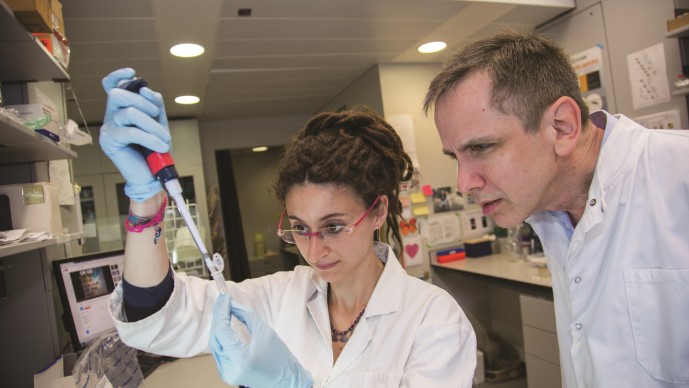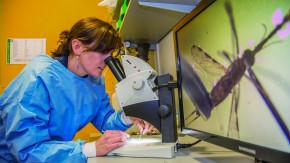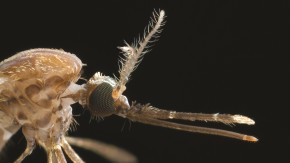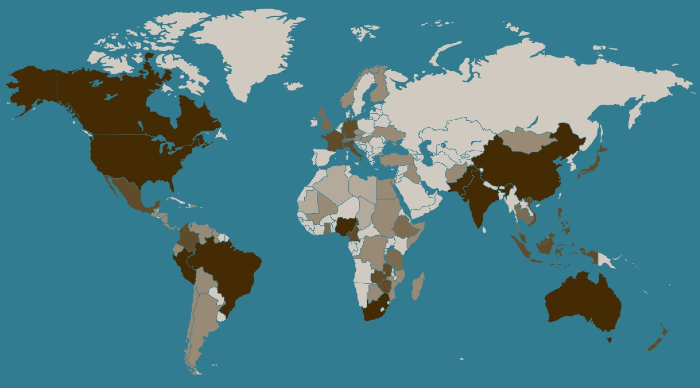Researchers in the insect room where mosquitoes are bred for the lab.
HOMING ENDONUCLEASE GENES: NEW TOOLS FOR MOSQUITO POPULATION ENGINEERING AND CONTROL
- Jan 1, 2016
- Download Retrospective

Austin Burt looks on as a lab member experiments with homing endonuclease genes (HEGs). They have been modifying HEGs in the laboratory to damage one of the sex chromosomes in mosquitoes as a way of controlling malaria transmission.
Austin Burt, Imperial College London, United Kingdom
In 2001 Austin Burt, a researcher at Great Britain's Imperial College won a modest grant from the Wellcome Trust to explore whether a rare bit of genetic material found in algae, fungi and yeast could be harnessed to wipe out malaria. "The Wellcome scheme encouraged the pursuit of big ideas for which there wasn't a lot of prior data and that might not work," recalls Burt. "This one certainly fit."
A Canadian native and evolutionary biologist, Burt at the time was one of a small group of scientists researching "selfish genes” short lengths of DNA that can get inserted into an organism's genome and then spread through a population over succeeding generations. While Burt had only studied the unusual genes in yeast, by 2001 he began thinking about how the selfish gene's unusual mode of action could be used to cripple large populations of the mosquitoes that transmit malaria.
There were about 198 million cases of malaria reported in 2013 and an estimated 584,000 malaria-related deaths, most of them among African children, according to the World Health Organization. In Africa, most infections are due to a bite from the Anopheles gambiae mosquito that acts as a disease vector by capturing the malaria parasite P. falciparum from the blood of an infected person, allowing it to reproduce, and then ferrying the numerous copies into the bloodstream of another bitten individual. Once in the blood, the parasites multiply rapidly and cause anemia, breathing problems and, in the disease's most severe form, cerebral damage, which is especially dangerous to infants. As the female Anopheles generally bites during the late evening to obtain blood to nourish fertilized eggs, bed nets bathed in chemical repellants and pesticides have become an effective way to protect sleeping children and others. Mortality rates among the young have declined about 58 percent between 2000 and 2013, likely a result of a concerted campaign across Africa to provide children with bed nets containing a mosquito repellant, the WHO reports.
But the mosquitoes keep developing resistance to the pesticides, not all mosquitoes feed in the night-time, and not everyone has access to or wants to use bed nets, so finding new ways to thwart the insects has become a major objective of the Bill & Melinda Gates Foundation and other public health organizations. Health officials now believe that any strategy short of totally ridding all vestiges of malaria will eventually fail. That's because even a small remnant of the disease in one locale can readily spread elsewhere due to the female mosquitoes' aggressive blood-seeking behavior, as well as migration of infected people into areas where the infection has been cleared. Without an anti-malaria vaccine that is 100% effective and given the likelihood that existing drugs or pesticides will lose effectiveness, a genetic approach that disrupts a mosquito's lifecycle, in concert with other new and existing methods, could be a more sustainable way to eradicate the disease, Burt says. The £125,000 (approximately US$200,000) Wellcome grant "gave me time to think how this might work," he says.
Burt says that at the time he knew next to nothing about malaria or mosquitoes, but he was well versed in the unique behavior of a class of selfish genes known as "homing endonuclease genes," or HEGs, first studied in simple organisms. Each type of HEG produces an enzyme that recognizes and acts upon a particular DNA sequence. When a cell activates a HEG on one chromosome, the scissors-like action of the enzyme it produces snips apart its target DNA sequence on the opposite chromosome. Moreover, as the cell tries to repair the break, it may copy the HEG from the opposite chromosome into the site, a process called "homing" making it more likely that the HEG will be passed on to future generations. By placing a disruptive HEG into a specific gene on a chromosome, the protein encoded by the target gene can't be produced.
In 2003, Burt published a report of his Wellcome-funded research containing a theoretical description of how a HEG might be used to fight malaria.[1] Burt proposed to use the HEG's chromosome cutting action as a genetic form of reproductive suppression targeted specifically against malaria-transmitting mosquitoes. Using different approaches, HEGs could reduce overall reproductive capability within that particular mosquito population by reducing mosquito numbers and thereby lowering the potential for malaria transmission.

By working out the mathematics of inheritance, Burt predicted that a small number of these modified insects released into a given area to mate with native mosquitoes could become the predominant population within 20 generations, or about two years, leading to the potential disappearance of the area's population of malaria-transmitting mosquitoes.
The next year, Burt organized a consortium to apply for one of several grants offered by the Bill & Melinda Gates Foundation's new Grand Challenges in Global Health (GCGH) grant program to support research into innovative ways to protect people from the malaria-carriers. On the basis of concepts worked out in Burt's paper, the consortium won a five-year, US$8.9 million GCGH award to bring his ideas to life. First, the consortium had to determine whether the genetic mechanism only seen in lower organisms also could alter genes in an insect. They started with a well-studied species that they thought would provide an easy answer, Drosophila melanogaster, the simple fruit fly. In parallel, the consortium researchers would begin testing the concept in Anopheles gambiae, the most important malaria vector in Africa.
"It was a novel, yet simple, elegant approach," says Stephanie James of the Foundation for the National Institutes of Health (FNIH), who was hired by the GCGH program to oversee the Burt project. "Getting it to work in mosquitoes and getting it accepted was going to be the challenge," she says. Despite numerous scientific hurdles, the project "had a real chance of saving lives," she says.
The approach is especially notable because "it precisely targets the small number of mosquito species that transmit malaria and kill millions of children over time," says Fil Randazzo, a Gates Foundation staffer who also monitored the project. "The environmental footprint should be pretty small."
Even before he won the Gates grant, Burt faced a significant scientific challenge. He had studied the natural history of homing endonucleases extensively in yeast. But his lab lacked the expertise to design endonucleases that could recognize and insert themselves into the specific mosquito reproductive genes the researchers wanted to alter. The solution came with unintended help from Oliver Morton, a science journalist who wrote an article about Burt's 2003 paper for the New Scientist magazine.[2] For the story Morton tracked down David Baker, a protein engineer at the University of Washington in Seattle, who unbeknownst to Burt had begun working on redesigning these enzymes in an attempt to repair the mutated genes that cause inherited diseases. Baker told Morton that he believed his lab could design "nucleases with novel specifications in six months" of taking on such a project. Baker, along with Barry Stoddard and Ray Monnat, also in Seattle, were enlisted into the consortium to do just that.
The task of testing HEG in fruit flies fell to Steve Russell and Michael Ashburner, two members of the consortium at the University of Cambridge. At the same time, Andrea Crisanti's lab, at Imperial College, undertook the same experiments in mosquitoes. "Turns out Drosophila wasn't the best organism to work this out in," says Burt. If he hadn't gotten the Gates grant, Burt says, he might only have tested his system in Drosophila. "We may have been sufficiently disappointed that we would not have continued," he says.
In a paper published in 2007, Nikolai Windbichler in the Crisanti lab reported the promising observation that HEGs inserted into Anopheles cells were functionally active.[3] In a second report in 2008, the lab showed that expression of one of these HEGs, which cuts a DNA sequence on the X chromosome, in the testes of male mosquitoes resulted in production of mostly Y chromosome-bearing sperm - which would be expected to produce mostly male progeny upon mating.[4] (Male cells contain an X and a Y chromosome, while females have two copies of an X chromosome, and only females bite people and transmit disease.)
To accomplish their ultimate goal of eliminating the population of malaria-carrying mosquitoes, they had to create HEG-bearing mosquitoes that could mate productively, so the desired trait would be passed on to subsequent generations. In 2014, the lab showed that with a minor change in the HEG, the X chromosome disabling trait could be passed along to the progeny, leading to a preponderance of males in a population,[5] just as Burt had hypothesized back in 2003.
For the alternative approach of reducing the overall numbers of mosquitoes to work, the consortium had to show not only that HEGs could cut and inactivate a target DNA sequence, but that they also could "home" in mosquitoes. In a 2011 report in the journal Nature, the Crisanti lab showed this, too, could be accomplished.[6] The researchers first created a breed of mosquitoes with a gene that expresses a green fluorescent color that is readily identified. The team then mated these mosquitoes with a separate group that contained a HEG that disabled the color-making gene. After 12 generations, more than half the offspring lacked the fluorescent gene, suggesting that a gene-disrupting trait could be passed along efficiently to succeeding generations. The lab has since identified several fertility genes in female mosquitoes that if deactivated might reduce populations efficiently. Although suitable gene targets, required for female fertility or other essential functions, must still be verified in the mosquito, the consortium now had good evidence that both of Burt's proposed approaches for eliminating malaria-carrying mosquitoes - reducing female offspring and disrupting female fertility - could work.
As a result of this initial success, Burt's consortium received a two-year, US$4 million extension of the GCGH grant in 2010. Two years later, the team was awarded a four-year, US$19 million grant to further the lab experiments and begin setting up experiments in large indoor cage facilities, as part of a collaboration with the University of Perugia. Experiments in these large environmentally controlled cages bring the project one step closer to the conditions that would be encountered in nature. Beginning in 2011 the project, now named Target Malaria, used the new funding to help establish field sites in collaborations with local scientists in Mali, Burkina Faso and Uganda who have expertise in medical entomology and genetics.
By 2015, the African researchers began studies of the native mosquito populations, focusing on male mating behaviors in preparation for releasing the genetically altered males. "The information we needed was new because most mosquito research has been focused on female biology as they are the ones who transmit malaria," says Abdoulaye Diabate, an entomologist who leads the field operations at the Institut de Recherche en Sciences de la Sante / Centre Muraz in Bobo Dioulasso, Burkina Faso's second largest city. Diabate's staff is readying laboratory facilities and the expertise to conduct contained laboratory experiments showing that the modified males will be able to successfully compete against native mosquitoes in mating with local females.
"It is incredibly important to gain a very detailed understanding of the mosquito in the field where modified mosquitoes will be dispersed if we are going to have the impact we want," says Mark Benedict, a research biologist and consultant to the U.S. Centers for Disease Control. Benedict is advising the field operations for Target Malaria in Burkina Faso and also in Mali, which is being run by Mamadou Coulibaly at the Malaria Research and Training Center, University of Bamako, and in Uganda, run by Jonathan Kayondo of the Uganda Virus Research Institute.
While lab experiments have shown proof-of-principle of the ideas first proposed back in 2003, the consortium's next step is to validate amongst a number of candidates "the most suitable fertility gene to disable, an enzyme to cut into that gene, and DNA sequences to turn on the enzyme at just the right time during embryo development," says Burt. Based on what was accomplished by 2014, he says he is confident the team will produce appropriately modified mosquitoes that will be validated in Italy and then by the collaborating partners in Africa for their ability to successfully reduce malaria-carrying mosquito populations.
"This is one of the most complex projects I've been involved with," says James. "The science is progressing rapidly and the evidence accumulated thus far supports optimism for successfully developing the desired product." But, she and others associated with the venture add that success also will depend on public acceptance, including regulatory and community authorization. "When all that falls into place, then we will be able to call it a real success," James says. "The next few years will be very exciting in that regard."
THE SCIENCE:
Distorting the sex ratio of mosquitoes using homing endonucleases
Burt and colleagues are working on methods to reduce the numbers of malaria-carrying mosquitoes in Africa to a point where disease transmission can no longer be maintained. Their first focus is on mosquitoes in the Anopheles gambiae complex, which contains some of the most deadly malaria vectors. One of the strategies they are pursuing is to bias the sex ratio of these mosquitoes towards males as a mechanism to reduce reproductive capacity within the population. They exploited a homing endonuclease gene (HEG) 1-Ppol from the slime mold Physarum polycephalum . This site-specific DNA endonuclease recognizes a highly conserved 29bp sequence in rDNA.[7] The essential 28S rDNA repeats containing this recognition sequence are located solely on the X chromosome in An. gambiae providing a mechanism of selectively cleaving and thereby inactivating the X chromosome in sperm. Thus, only Y-containing sperm and consequently male offspring would result.[1]
HEGs are selfish genetic elements not native to metazoa, but Burt, Crisanti and colleagues have proven they can function in mosquitoes[3] Crisanti and team generated transgenic males carrying I-Ppol under control of a testis-specific promoter to target expression during spermatogenesis.[4] These mosquitoes indeed only generated Y-containing sperm, but also produced inviable offspring due to persistent HEG activity in the zygote. These sterile male mosquitoes provide a useful tool for studying the technology, but were not the ultimate goal. Therefore, they generated shorter-lived variants of I-Ppol to restrict its activity to male meiosis. The release of one of these strains at three times the numbers of a caged wild-type population led to elimination in four out of five cages within six generations. This demonstrates proof-of-principle that I-Ppol transgenic mosquitoes can reduce mosquito numbers significantly.[5] The next step will be to insert I-Ppol on the Y chromosome so it will be passed on to progeny and become self-sustaining within the population, leading to large-scale and long-term reduction in mosquito numbers.
REFERENCES:
[1] [a],[b] Burt A. Site-specific selfish genes as tools for the control and genetic engineering of natural populations. Proc. Roy. Soc. Lond. B. 270, 921-8 (2003).
[2] Morton, O. Splat!, New Scientist, 2387 (2003).
[3] [a],[b] Windbichler N, Papathanos PA, Catteruccia F, Ranson H, Burt A, Crisanti A. Homing endonuclease mediated gene targeting in Anopheles gambiae cells and embryos. Nucleic Acids Res. 35, 5922-33 (2007).
[4] [a],[b] Windbichler N, Papathanos PA, Crisanti A. Targeting the X chromosome during spermatogenesis induces Y chromosome transmission ratio distortion and early dominant embryo lethality in Anopheles gambiae. PLoS Genet. 4, e1000291 (2008).
[5] [a],[b] Galizi R, Doyle LA, Menichelli M, Bernardini F, Deredec A, Burt A, Stoddard BL, Windbichler N, Crisanti A. A synthetic sex ratio distortion system for the control of the human malaria mosquito. Nat Commun. 5, 3977 (2014).
[6] Windbichler N, Menichelli M, Papathanos PA, Thyme SB, Li H, Ulge UY, Hovde BT, Baker D, Monnat RJ Jr, Burt A, Crisanti A. A synthetic homing endonuclease-based gene drive system in the human malaria mosquito. Nature 473, 212 (2011).
[7] Muscarella DE, Ellison EL, Ruoff BM, Vogt VM. Characterization of l-Ppo, an intron-encoded endonuclease that mediates homing of a group I intron in the ribosomal DNA of Physarum polycephalum. Mol Cell Biol. 10, 3386 (1990).
Explore More Grand Challenges in Global Health retrospective (2005-2015)

Introduction (GCGH: 2005-2015)
Jan 2, 2016
Antigen Design (Hill)
Jan 1, 2016
Antigen Design (Kappe)
Jan 1, 2016
Chemical Vector Control (Axel, Vosshall)
Jan 1, 2016
